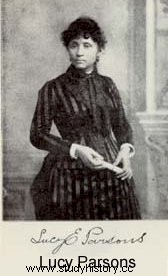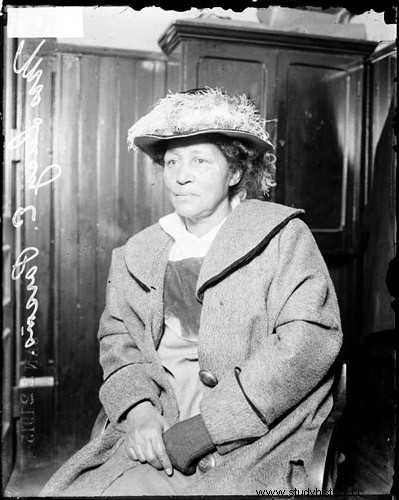Lucy Eldine Gonzalez Parsons (1853 – 1942) was an American anarchist activist. A talented speaker, she also left articles and pamphlets denouncing racism and the living conditions of the workers, as well as a biography of her husband, executed in the case of the Haymarket Square bombing.
The birth of an activist
 Of African American, Mexican and Native American descent, Lucy Eldine Gonzalez was born in 1853, probably in Texas. Little is known of her childhood and family, except that she was likely born a slave. She thus knew slavery until its abolition in 1865, when she was 12 years old. In 1871, at the age of 18, Lucy married Albert Parsons, who was a former member of the Confederate army. In Texas, this mixed marriage is almost illegal and very badly accepted. Facing death threats, the two young spouses, who will have two children, move to Chicago.
Of African American, Mexican and Native American descent, Lucy Eldine Gonzalez was born in 1853, probably in Texas. Little is known of her childhood and family, except that she was likely born a slave. She thus knew slavery until its abolition in 1865, when she was 12 years old. In 1871, at the age of 18, Lucy married Albert Parsons, who was a former member of the Confederate army. In Texas, this mixed marriage is almost illegal and very badly accepted. Facing death threats, the two young spouses, who will have two children, move to Chicago.
Lucy and Albert continue an anarchist militant commitment already undertaken in Texas, in favor of the rights of blacks and workers. Lucy earns her living by sewing clothes, while her husband works in a printing press. The two begin to write in socially-engaged journals, tackling social issues such as the civil rights of African Americans or the situation of the unemployed, women, political prisoners, the homeless. . Albert's anti-capitalist remarks get him fired from his job at the Chicago Tribune , the city newspaper. Lucy frequents the workers of Chicago, particularly in the textile factories where the working conditions are extremely difficult. Supported by her husband, she founded the Chicago Union of Working Women. to defend their rights.
In 1883, the two spouses, with a few other activists, founded the International Working People's Association (IWPA). Lucy writes articles and pamphlets for The Alarm , the journal of the organization. Concerning the working conditions of workers, demands quickly crystallize around the issue of working time. Many have to work between 15 and 18 hours a day to support themselves and their families. Lucy and Albert campaign for the 8-hour day, and the workers call for a one-day strike for May 1, 1886. Lucy and Albert, who is already considered by the authorities and the press as a dangerous activist, march with their children.
Black Friday
 On May 4, a rally is held in Haymarket Square, and Albert speaks there before leaving the scene , like most participants. As the crowd disperses, the police charge the two hundred remaining demonstrators. Someone then throws a pipe bomb and kills a policeman. The police retaliate by opening fire. The number of dead is not known, but the authorities declare a state of emergency and institute a curfew. In the following days, many workers were arrested; some are tortured. Albert flees but, when seven militants are accused of the Haymarket murders, he gives himself up to the police. After a mock trial, where a relative of the killed policeman is accepted as a member of the jury, Albert and six of his companions are sentenced to death. The judgment triggers a wave of international protest and three of the death sentences are commuted to life imprisonment. One of the other convicts commits suicide in prison.
On May 4, a rally is held in Haymarket Square, and Albert speaks there before leaving the scene , like most participants. As the crowd disperses, the police charge the two hundred remaining demonstrators. Someone then throws a pipe bomb and kills a policeman. The police retaliate by opening fire. The number of dead is not known, but the authorities declare a state of emergency and institute a curfew. In the following days, many workers were arrested; some are tortured. Albert flees but, when seven militants are accused of the Haymarket murders, he gives himself up to the police. After a mock trial, where a relative of the killed policeman is accepted as a member of the jury, Albert and six of his companions are sentenced to death. The judgment triggers a wave of international protest and three of the death sentences are commuted to life imprisonment. One of the other convicts commits suicide in prison.
Lucy Parsons attends the trial. One witness describes her as "unyielding and intelligent like him, one who doesn't blink even in the worst situations, who speaks with vibrant energy in public gatherings, who doesn't faint like the others, who doesn't shows no movement on her face as she hears the fierce condemnation…”. After the verdict, Lucy and her children travel the country to plead Albert's case and denounce the injustice of his trial. But on November 11, 1887, Albert Parsons, August Spies, George Engel and Adolph Fischer were executed on "Black Friday". Thereafter, the bosses apply the eight-hour day. In 1889, in homage to the martyrs of Chicago, the Congress of Socialist Workers established May Day as International Workers' Day.
“We are the slaves of slaves”
After the death of her husband, Lucy Parsons continues the fight, with the workers in particular. In June 1905, she participated in the creation of the creation of the Organization of Workers of the World, in Chicago. A confirmed speaker, she takes the floor in particular to denounce the fact that women have neither the right to vote nor political representation."We are the slaves of slaves" , she says. Attached to the liberation of women, she thinks that their emancipation must go through that of the working class. In ideological and personal conflict with the anarchist activist Emma Goldman, she opposes her in particular on feminism. Unlike Emma Goldman, Lucy analyzes the oppression of women as a constituent of capitalism and does not separate it from the oppression of the working class.
Lucy continued to speak publicly and write anarchist articles and pamphlets, even in the French newspaper Les Temps Nouveaux. She edits the anarchist newspaper The Liberator herself. , and published The Famous Speeches of the Haymarket Martyrs , a report of the last words spoken by the Chicago martyrs at their trial. She organized several strikes, notably in Chicago in January 1915. In 1925, she joined forces with the International Labor Defense (ILD), a communist civil rights organization. In 1939, she reportedly joined the Communist Party. In 1941, although nearly 88 years old, Lucy was still speaking in public. Despite her advanced age, the police still consider her "more dangerous than a thousand insurgents".
Lucy Parsons died in her Chicago home fire on March 7, 1942. Her companion of 30 years, George Markstall, died the following day from injuries received while trying to save her. After his death, the police seized all his books and personal notes.
